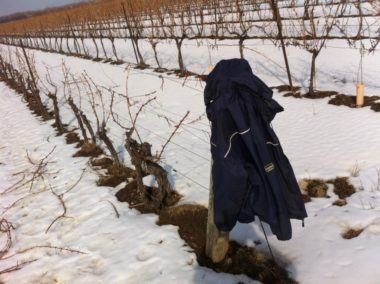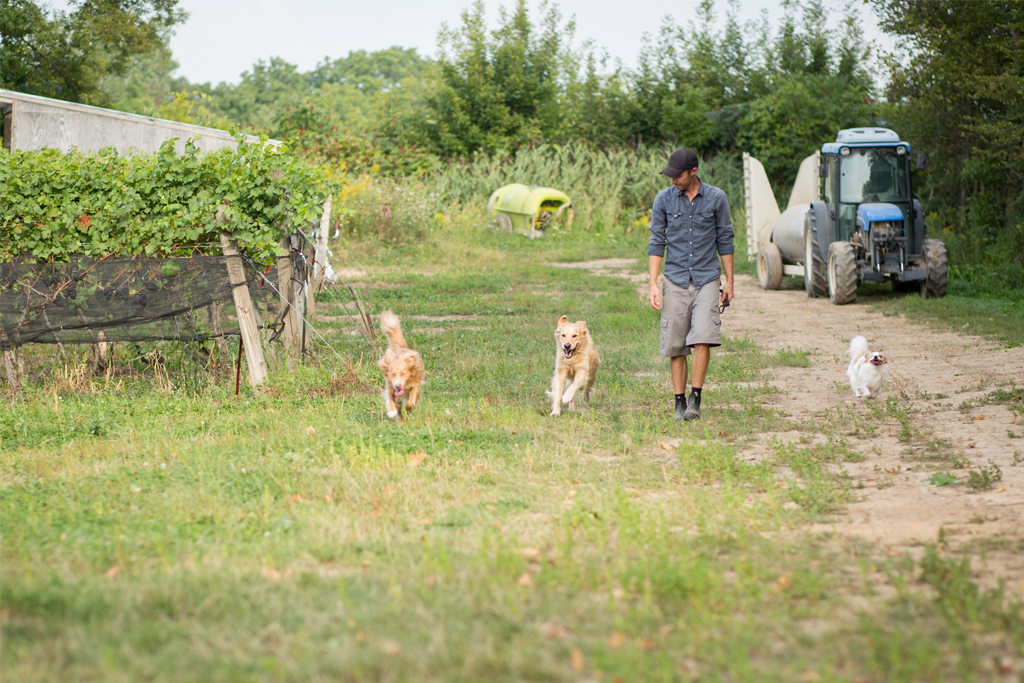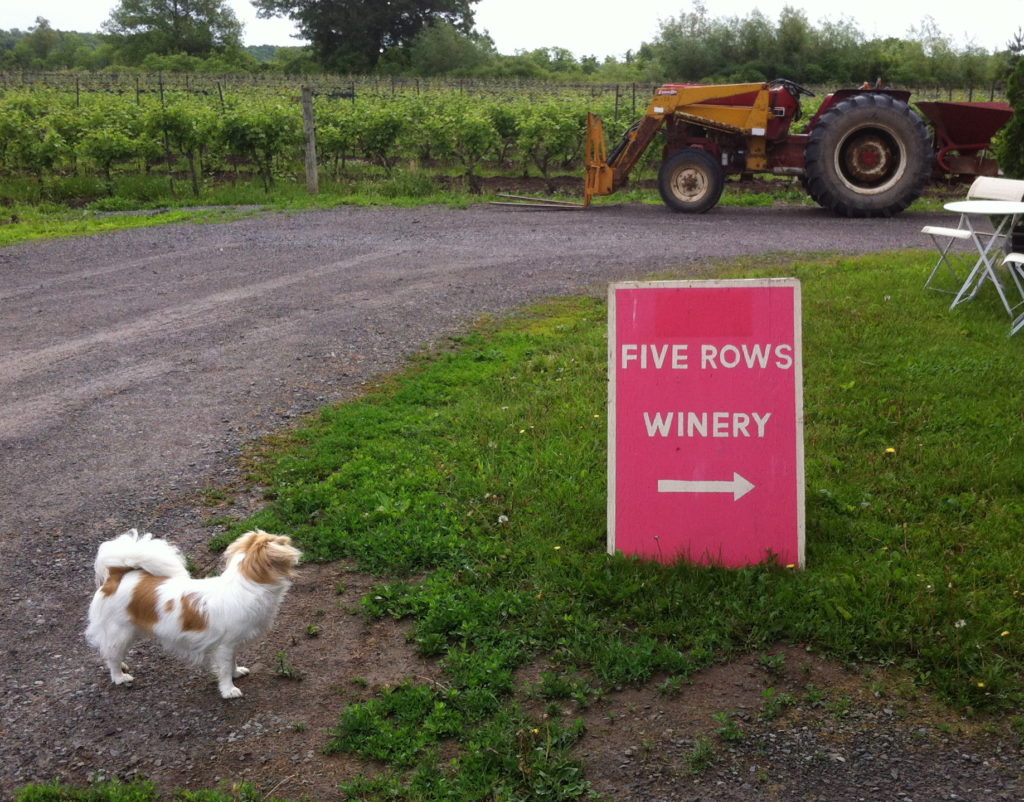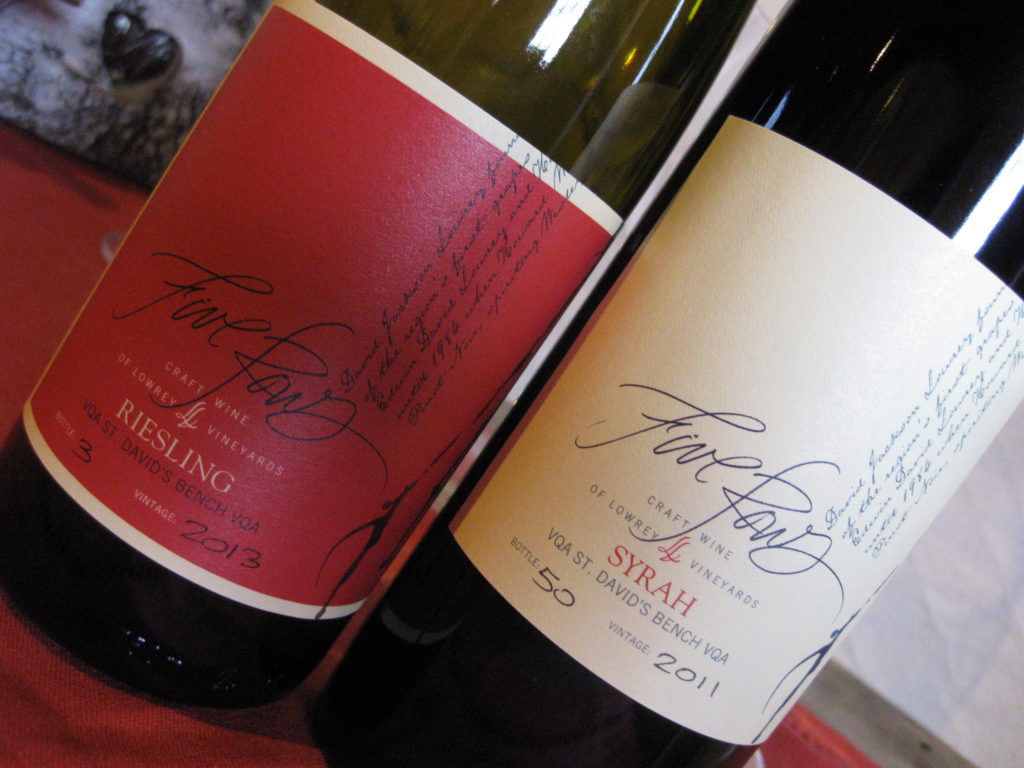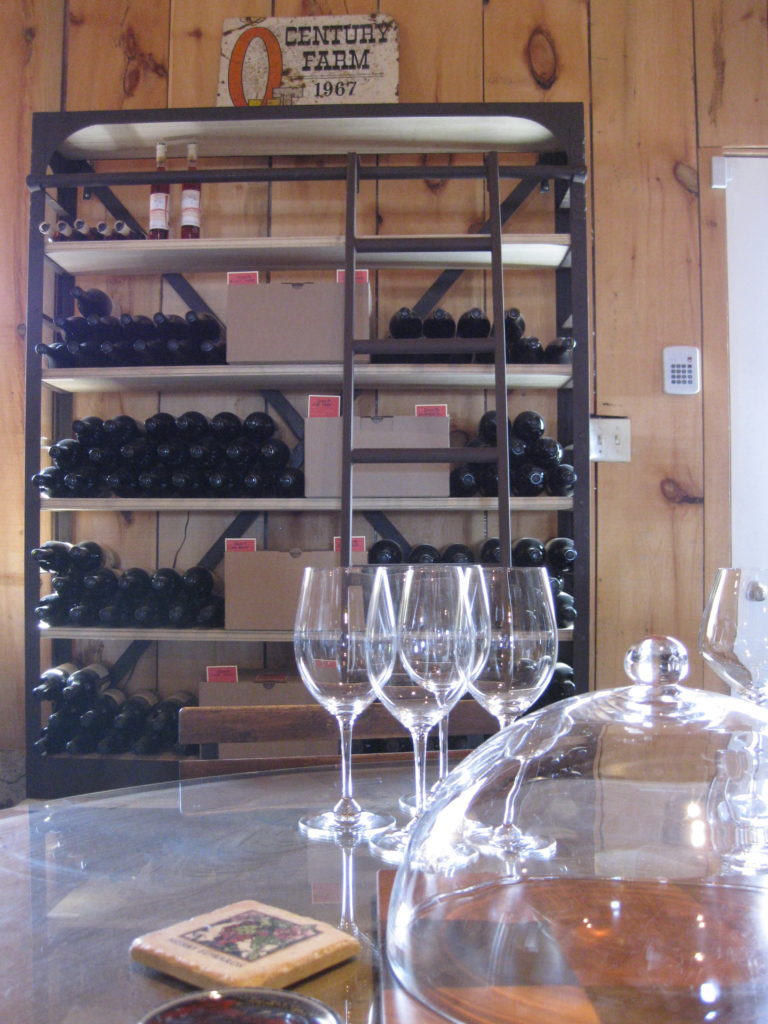Cheers to A Successful Season!
My first experiences with the marathon that is a winery-based harvest came at Blomidon Estate in Nova Scotia, then later back in Ontario at Creekside. I was completely unprepared for the long haul that loomed ahead.
Prior to Blomidon I was only familiar with the limited perspective of the grape grower. When the crop was off, your job was done! I was ignorant to the efforts that went into processing and fermenting our freshly picked fruit. My early days in Nova Scotia taught me that it was far more difficult being responsible for the combined task of growing the grapes and making the wine. Despite the initial ass-kicking, I somehow rationalized starting my own winery just a few years later.
I took much of what I learned at Blomidon and applied it at Five Rows. As a smaller producer than most, I concede we have it easy compared to the big guys, and that is partly by design. Our collection of varietals lends itself to a nice even picking schedule, with a bit of a break mid-harvest. While everyone else is taking in Chardonnay and Merlot, we usually have the time to finish up pressing Pinot Noir and begin preparation for Syrah and Cabernet Sauvignon.
Each vintage is it’s own beast, a grueling battle with much reward at the end. Days seem to go on forever early in September then rapidly get shorter as the season draws to a close. The evening feast is the shining beacon at the end of each day and beer becomes your religion.
Then rather abruptly, like a wall of lake effect snow, it’s all over and you are left wondering what to do with yourself. You are conditioned to getting up and hitting the ground running, now there is actually time for reflection and leisure. The daily caffeine and adrenalin rush is no longer required, but can be hard to ween yourself from.
Mostly you try to get back to a normal life. Your significant other barely remembers who you are and rightfully expects you to make up for three months of being absent and tired. So now is the time to give back.
This year I spent my first day of “freedom” raking leaves in the snow, walking the dogs and picking up groceries…and enjoying every minute of it!
The End is Near
So it all comes down to this. November is upon us and all grapes are off, save the few robust rows Cabernet Sauvignon we’ve chosen to hang until the bitter end.
They desperately cling to their yellowing leaves as the last few rays of fall sunshine hopefully find enough green chlorophyll pigments to move the ripeness needle just a bit further in our favour. They are likely ripe enough to pick, but they are also clean enough to hang until all the foliage has been exhausted. Every tick of extra sugar and reduction in total acidity is a welcome bonus at this stage.
It is the exact scene I anticipated earlier in the Spring as all varietals got off to a sluggish start. We knew we would be pushing the limits to make quality wine – we had no other choice. The thought of hand-harvesting in the bitter, damp cold of November is intimidating, but when you are so close to the end of a long season, motivation seems easier to summon and these days can actually prove to be glorious!
The most harrowing part of this waiting game is the relentless nature of the birds. They are wiser and more brazen by this time in the season, blatantly ignoring bird-bangers and finding creative ways to circumvent our seemingly impenetrable nets. The only true deterrent is a crazed farmer willing to spend the entire day riding around in his vehicle of choice, unleashing whatever unholy racket he can muster. They will undoubtedly have nightmares about what these frustrating flocks are doing to their grapes, it is what drives them to be up at the crack of dawn to do it all over again.
2014 Harvest Update
What a luxury it was to be given a dry stretch of days to harvest all of our early varietals. I don’t recall a ripening period this ideal in all the years I’ve made wine.
Fall picking decisions are usually based upon rotten fruit and looming rain in the forecast. We weren’t entirely spared the former, but the lack of the latter allowed us to delay harvest dates until all the important parameters reached absolute perfection. Warm days to drive photosynthesis and accumulate sugar, and cool nights to maintain acidity and control fruit flies. I actually felt a bit greedy leaving some of our fruit on the vine as long as we did, but this rare ripening window was just too tempting not to take advantage of.
The Pinot Noir fermentations smell absolutely splendid! The Pinot Gris and Sauvignon Blanc were allowed to hang long enough to develop the most wonderful flavours to go with the desired sugar and acidity levels. As expected, crop levels were light, but the fact we had any fruit to harvest this vintage is a victory in itself.
It appears as if this little run of nice weather might be coming to an end, but I will not soon forget the exquisite fall scene of 2014.
A Summer To Treasure
If I’m guilty of anything during the busy build-up to harvest, it’s failing to take the time to appreciate the wonderful summer we’ve just had welcoming so many visitors to our barn. I tend to spend these days with blinders on, dutifully focused on protecting my delicate grapes from birds, fruit flies, rot and botrytis. A little rosy reflection always helps keep my chin up.
I never would have fathomed that a barn jam-packed with 750 cases of wine could be reduced to what I see today, a mere four months from the initial release in May. Every one of our visitors has contributed to this case reduction – one bottle, one case at a time. I was touched this year by the number of fellow winemakers and industry personnel who took time out of their busy schedules to stop by and purchase our wine. This is a favour I vow to repay very soon!
It is through the tireless hosting efforts of Wilma, Tracy and Katie that we’ve somehow been able to sell nearly every hand-numbered, hand-labeled bottle of Five Rows wine that was bottled and waxed this Spring. Selling out of wines is always a sad time despite what you might think. A common refrain we hear is that this is a “good” problem, but I would argue that there is no such thing as a “good” problem. Having no wine to offer those who’ve traveled far and wide to locate our barn, only to discover we are sold out of their treasured new find is excruciating for visitor and host alike.
This situation always provokes a sinking feeling, as it was never my intention to make a wine that became more “sought after” than actually bought and enjoyed. The goal every year is to make memorable wines, but not for the wrong reason. Do we need to produce more Sauv Blanc? Would that make more people happy? Perhaps, but maybe not…
The logistics of producing more wine the way we currently go about it (i.e. one guy doing all the tractor work and one guy doing all the winemaking) is not conducive to a dramatic increase in volume. Moreover, I’m an intense creature of habit (and by habit I mean stubborn and superstitious), so making a change to a formula that works is not something I’m comfortable with. Change is my kryptonite.
As I’ve written in the past, it is the reliable patronage and warm compliments from our friends and supporters that drive my passion for making wine. For these people we will gladly endeavor to keep the Five Rows experience a familiar one.
I’m happy to report that we still do have a limited quantity of 2011 Pinot Noir available, so please join us for a chat and taste over the exciting months of harvest. Don’t let the bird bangers scare you away!
Big Berries and Happy Vines
I’ve decided to initiate this writing by optimistically pouring myself a half full glass of 2011 Pinot Noir.
In what seems like the wettest summer in recent memory, there have been a few positives. Not the least of which is that I now know it’s possible to grow grapes in a climate where it rains every other day. The vines are indeed lush and happy, but ripening this crop of monster-sized berries could prove to be the rub.
It may be a blessing in disguise that our poor, winter-ravaged vines were treated to a stressless year such as this. We haven’t exactly been afforded the heat units and dry conditions seen in “glorious” years like 2010 and 2012, but that isn’t the be-all and end-all of crafting decent wine. I’ve come to accept this stubbornly, as people continually seem to prefer the wines we’ve made in less extreme years like 2009 and 2011. The superior elegance and early approachability of these vintages has been surprisingly matched by their ability to age splendidly. However, given the choice I’d take the easy growing season every time!
I shudder at the memory of the nightmare harvest of 2011, and that optimistic glass of Pinot suddenly becomes half empty. I start to worry that even an unprecedented two month stretch of dry heat may not be enough ripen our beautiful (but late) crop of Cabernet Sauvignon. Due to the sluggish start and lack of sumer heat, we’ve had to thin the crop down to its lowest level since 2009 and the cluster and berry sizes are reflective of that – GARGANTUAN! Winemakers are not generally fans of big berries, although farmers like my dad love them. Larger berries tend to be more dilute in terms of flavour and suffer from lower skin to juice ratio, not the textbook combo for premium wine.
Perhaps it’s too early to worry about such things. The glass is now empty.
Rainy Day Winemaker
It occurs to me, as I hit a few golf balls into my Cabernet Sauvignon early on this Sunday morning, that we’ve evolved into a rather unconventional winery. I don’t know what triggered this random thought – perhaps the vision of a Winemaker more intent on grooving a sand wedge than racking barrels…warped priorities indeed.
Admittedly, I’ve morphed into a “rainy day” Winemaker of sorts, as there are just too many jobs to do in the vineyard when the sun is shining and field conditions are ideal. It is on those rainy days when I employ some techniques that most would consider uncommon (certainly not smart) oenological practice.
I’ve learned the hard way that gravity-siphoning Syrah, on a tipsy ladder into two barrels simultaneously, will most assuredly lead to a violent Syrah volcano that is not discriminate about where it splatters. This is especially problematic when your winery space is also a retail store lined with finished packages. Those “specially stained”, collector’s edition bottles are now reserved exclusively for family and friends.
The eccentricities do not end there. I’m not sure how many Winemakers must arrange daily tasks around their mother’s laundry schedule, but I’m willing to bet there are only a few of us. You see, water pressure is of the utmost importance in cleaning both tartrate-laden oak barrels and Wilma’s linens. Despite these limitations, the wines get made and our whites are still bright.
Those visiting our barn on weekdays can attest that it doubles as a very large dog house. A stickler to routine, my days are planned around letting my dogs out at a quiet time when they won’t bother our guests. I treasure these few moments of leisure and serenity…
That is until my one-eyed King Charles Cavalier x Chihuahua, named Bella, becomes seemingly possessed by a Tasmanian Devil. It usually begins with her running really fast in large circles (one-eyed dogs tend to do this) eventually setting out on a wild foray into the vineyard despite my attempts at verbal restraint. Onlookers sit back and enjoy the spectacle, often marveling, “Look at her go!” And go she does. I’d like to say that I play it cool and never get sucked into chasing her…but that would be a lie. Picture Forrest Gump chasing a weasel.
A more fitting winery mascot would be hard to find.
An Explosion of Pinot
Those unfamiliar with the otherworldly vigour exhibited by Pinot Noir grapevines in early June are welcome (and encouraged) to witness this phenomenon firsthand, before the dramatic shoot-thinning begins.
It is actually comical to see how much growth these vines can throw in ideal conditions. For every shoot there is a secondary, for every secondary there are three suckers. This all adds up to mayhem. Observing Pinot at this stage leads one to wonder if these vines could ever be fashioned into something resembling “organized”.
Over the next few weeks I will tackle this chaotic cluster of green with hopes of taming my Pinot into submission. Sadly, I already know this is a losing proposition, but what I lack in smarts I make up for in persistence. This is a key job that sets the tone for producing good, clean Pinot Noir.
If you do decide to visit in the coming days I would suggest bringing along a machete and ample hydration. If you can find me, I will happily teach you the ways of the jungle.
Overwhelming Response
I’m overwhelmed at the response we’ve received to our new wines and the number of keen visitors we’ve entertained over the last couple of weeks! It is all we can do to write and apply labels fast enough to keep up.
I’ve become accustomed to putting off my vineyard work on weekends in May to stick around the barn and help the girls with tastings. I must admit that I secretly enjoy this, as it allows me to overhear all the interesting and thoughtful reviews of my wines. There is always a gut-wrenching fear belying my calm facade that these wines won’t live up to their predecessors. You would think that after nine vintages of wrenching guts I might have learned to trust my palate by now, but it always takes a few satisfied customers to reassure me.
That is all part of what makes this time of year is so exciting, from the inbox full of pre-orders to the smiling faces of return visitors parading through the barn door. The fact that people would think enough of our wines to pre-order them on spec, without even trying them first, is the ultimate in trust. I treasure this trust as much as any award or five star review we’ve ever received. The “pre-order” is my gold medal.
With that trust comes the pressure not to disappoint. This challenge drives what I do in the vineyard every summer. In the back of my mind is the knowledge that this vine I’m currently thinning will produce fruit to make a wine that someone may already have dibs on for next year. On one hand it’s a very reassuring thought, but it also means there isn’t much room for error!
As the first buds of 2014 start to reveal themselves one precious leaf at a time, I confidently venture out to the vineyard and strive to earn more trust.
New Wines
On the eve of the New Release here at Five Rows there is palpable anticipation is in the air. The barn is full, brimming with fresh wines ready to introduce themselves to some palates. Taking a mental snapshot of these tall stacks I recall the sheer amount of work that went into each one of these wines from the first moment of bud emergence until now. There is contentment in this reflection.
I leisurely wax the cork tops while Wilma pens and applies the new labels. Next weekend we will officially open for the year and debut all of the recently bottled 2013 whites and 2011 reds. Experience tells me that there will be nothing “leisurely” about the next couple of weekends, as all of our friends stop in to pick up their orders. It’s a whirlwind of visits and tasting, but we wouldn’t have it any other way!
The First Official Jacket Hanging of 2014
It’s official. March 10, 2014 marked the first outdoor workday of the year that I was compelled to take off my jacket and hang it over an endpost in a symbolic act of optimism. I don’t know that I’ve ever enjoyed a day of pruning (and fetching) this much. I guess it takes a long, cold winter to make a 7 degree March afternoon feel so heavenly.
Lucy will miss the snow.
